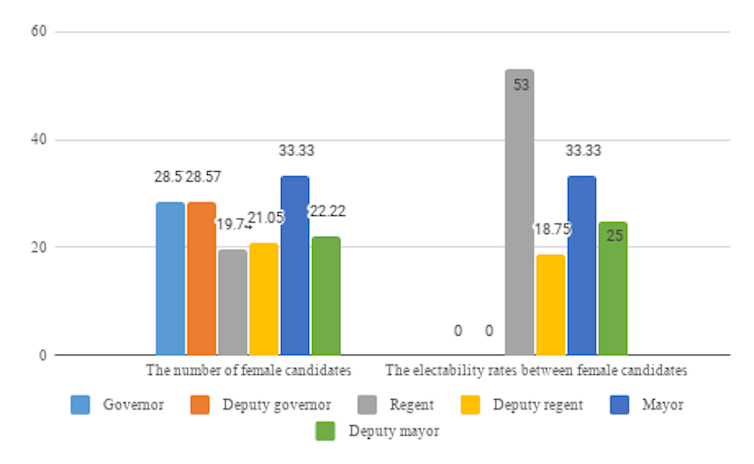THe Conversation: Women’s electability rises in Indonesia’s 2018 local elections
Women’s electability rises in Indonesia’s
2018 local elections
August 10, 2018 12.21pm AEST
The Conversation
Of 94 women who ran for
local government offices (governor, vice governor, regent and vice regent,
mayor and vice mayor), 31 (33%) were elected in 2018. This is almost 2% higher
than the previous year’s elections.
Overall, women won 31 out of 338 positions (9.2%) as local head and deputy
leaders.
Women's candidacy and electability in Indonesia's 2018 regional head election
| Level | Number of women candidates | % women's candidacy per level | Elected | % electability (elected /candidacy) | Regional head positions | Gender ratio (elected /total regional heads) |
|---|---|---|---|---|---|---|
| Mayor | 16 | 17,02 | 4 | 25,00 | 39 | 10,26 |
| Vice Mayor | 16 | 17,02 | 6 | 37,50 | 39 | 15,38 |
| Regent | 31 | 32,98 | 11 | 35,48 | 113 | 9,73 |
| Vice Regent | 24 | 25,53 | 7 | 29,17 | 113 | 6,19 |
| Governor | 2 | 2,13 | 1 | 50,00 | 17 | 5,88 |
| Vice Governor | 5 | 5,32 | 2 | 40,00 | 17 | 11,76 |
| Total | 94 | 31 | 338 |
Author's tabulation
Measuring women’s chances of winning in
Indonesia’s regional elections
The Conversation
The above patterns indicate that voting tends to favour
candidates having either family ties or connections with local leaders,
experience in the parliament or membership of political parties. These factors
are crucial in helping women secure political nomination as local leaders.
Political kinship – as the
wife or the daughter of the party elites or the current local leaders – is
often perceived as a catalyst for securing public votes.
Having a status as a
legislator also enables a candidate to establish an excellent connection with
the voters.
In addition, membership of
political parties helps female candidates to secure nomination, as most
candidates (both males and females) are nominated through political parties
under the current political system.
Such backgrounds, however,
have raised some concerns.
Power mapping
Due to the low percentage of female candidates in the country’s local elections, I will not measure their electability rates against male contenders. Instead, I will measure their chances of winning from other female candidates.
Let’s start by reviewing the power distribution of female candidates in the previous regional elections.
In 2015, 24 out of 57 female candidates won elections for regents and mayors. Twenty-one of them were elected as regents, while the remaining three became mayors. These winners accumulated 57.44% of votes on average.
The chances for women to win deputy positions at these elections stood at 33.33%, with victories for 22 of the total 66 female nominees. These winners secured 44% of votes on average.
Based on the above data, I argue that women have better chances of winning at the regency level. More than half of female candidates running for regents won the elections. Only one-third of female candidates won mayoralty positions (Table 2).
From various local government positions, women had bigger chances of being elected when they were running for regents (0.67) than for mayors (0.47), deputy regents (0.42) and deputy mayors (0.36).

Meanwhile, data from the 2017 elections showed that the turnout of female voters was higher than men’s, standing at 76.2%. Unfortunately, their votes did not all go to female candidates.


Comments
Post a Comment